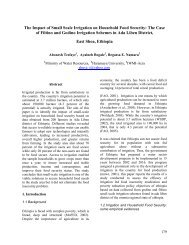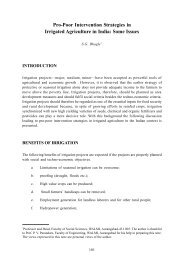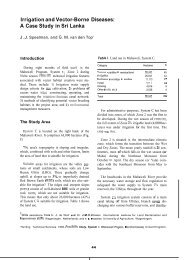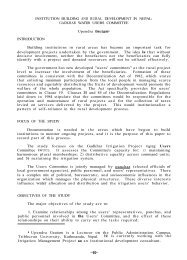WATER POVERTY IN THE NORTHEASTERN HILL REGION (INDIA)
WATER POVERTY IN THE NORTHEASTERN HILL REGION (INDIA)
WATER POVERTY IN THE NORTHEASTERN HILL REGION (INDIA)
You also want an ePaper? Increase the reach of your titles
YUMPU automatically turns print PDFs into web optimized ePapers that Google loves.
<strong>WATER</strong> <strong>POVERTY</strong> <strong>IN</strong> <strong>THE</strong> NOR<strong>THE</strong>ASTERN <strong>HILL</strong> <strong>REGION</strong> (<strong>IN</strong>DIA): POTENTIAL ALLEVIATION THROUGH MULTIPLE-USE <strong>WATER</strong> SYSTEMS13 Sections (household, demography, health status, assets, access to infrastructure, land tenure,land use patterns, access to water, annual income, household consumption, impact of external andinternal shocks, ecosystem services).3.3. Area ProfileThe study was conducted in Lampong Sheanghah village of Mon district in the state of Nagaland in India.The geographic location of northeast region is strategically important as it has international borders withBangladesh, Bhutan, China, Myanmar and Tibet. The rich natural beauty, serenity and exotic flora andfauna of the area are invaluable resources for the development of eco-tourism. The region has a highconcentration of tribal population. The states of Arunachal Pradesh, Meghalaya, Mizoram and Nagalandare mostly inhabited by a number of native tribes. Each tribe has its own distinct tradition of art, culture,dance, music and life styles. The numerous fairs and festivals celebrated by these communities and theirfriendly nature are irresistible attractions for the visitors.3.3.1. NagalandAmong the northeastern states, Nagaland stands out as a land of diverse tribes, systems of governance,cultures, sheer colour and variety. As its 16 major tribes hold their festivals each calendar month of the year,Nagaland is often referred to as the ‘land of festivals’. Nagaland represents sociological and anthropologicalgold mines because it is still scientifically unexplored. The state is bounded by Asom in the west, Myanmaron the East, Manipur in the south and Arunachal Pradesh and part of Asom on the north. It lies between25 0 6’ and 27 0 4’ northern latitudes and between 93 0 20’ and 95 0 15’ eastern longitudes (Figure 1).Nagaland attained statehood in December 1963 and became the 16 th state of the Indian union. Thestate has an area of 16,579 km 2 (which constitutes 0.5% of the country’s geographical area) witha population of 19,88,636 (0.2% of the country’s population) as per 2001 Census. The numberof households in the state was 149,000 in 1981, which increased to 217,000 in 1991. The state ispredominantly rural, with 82.3 percent of the population living in villages, generally situated onhigh hilltops or slopes overlooking verdant valleys. Till January 2004, Nagaland consisted of eightadministrative districts, with 52 blocks, nine census towns and 1,286 inhabited villages. Each districtgenerally has predominant concentration of one of the major/ minor tribes of the state, makingthe districts distinct in their socio-political, traditional, cultural and linguistic characteristics. Ofthe eight districts, Tuensang is the largest, occupying 25.5 percent of the total area of the state,followed by Kohima with 18.79 percent. The Naga Hills run through this small state, which hasSaramati as its highest peak at a height of 12,600 ft. The main rivers that flow through Nagaland areDhansiri, Doyang, Dikhu and Jhanji. The terrain is mountainous, thickly wooded, and cut by deepriver valleys. There is a wide variety of plant and animal life. Nagaland has a monsoon climate withgenerally high humidity; rainfall averages between 1,800 and 2,500 mm/ annum.The Nagas, inhabitants of Nagaland, are said to belong to the Indo-Mongoloid stock, a race whose presencewas first noted ten centuries before Christ, at the time of the compilation of the Vedas. The Nagas form morethan 20 tribes, as well as numerous subtribes, each having a specific geographic distribution. Though sharingmany cultural traits, these tribes have maintained a high degree of isolation and lack cohesion as a singlepeople. The Konyaks are the largest tribe, followed by the Aos, Tangkhuls, Semas, and Angamis. Other tribes10
















